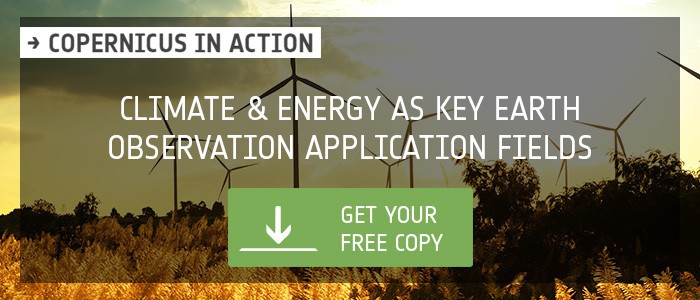Did you know Earth observation (EO) satellites aid in finding top wind and solar parks locations? Next to providing assistance to detect optimal locations for wind and solar parks on the global scale, Earth observation satellites also monitor extensively the sea for energy purposes. These are important assets, especially considering the high relevance of future renewable energy resources.
To tackle major causes of global climate change, for instance burning fossil fuels for energy, the international community is constantly in search of sustainable solutions. Within this context, renewable energies such as solar and wind power are on the advance worldwide. According to the Copernicus Market report 2016 – prepared by PwC for the European Commission –, the European renewable energy industry is reported to have generated EUR 147 billion turnover throughout the EU in 2015 and employed 8.1 million people in 2012. By 2020, a substantial amount of the EU’s energy supply should be provided by renewable sources. This development shows how promising this market really is in terms of business and benefits on the global scale.
Comprehensive Variety of the Copernicus Services
Copernicus – Europe’s flagship programme for Earth observation– provides a uniform system by which big data volumes are fed into a range of information services for a more sustainable future. Its main objectives lie in delivering products and services to manage and protecting the environment and natural resources, as well as ensuring civil security. The Copernicus services supply standardised multi-purpose information for a wide range of application fields. Those application areas are relevant to EU policies, many of which are implemented at national or regional levels aiming at sustainability and economic growth.
Each one of the service areas with its range of products is designed to meet the needs of identifiable groups of users – and thus the User Uptake is growing continuously. Since the Copernicus services have a comprehensive nature, they are divided into six main categories: land monitoring, marine environment monitoring, atmosphere monitoring, emergency management, climate change, and security.
The services provide information relevant to offshore wind farms, such as wind speed, wind fields, and wave size and frequency – just to name one outstanding example. These parameters are crucial in determining where wind energy can be generated in the most cost-effective way whilst reducing the risks of damage. In the case of solar energy, the Copernicus satellites facilitate the mapping of available solar radiation by monitoring the spatially and temporally highly variable clouds and aerosols that impact it. With respect to climate change, a fascinating example for high quality surveillance is the rapidly changing phenomenon of sea ice. Satellite monitoring enables the respective identification of risks and opportunities, including the opening of shipping lanes. Another example for monitoring climate change is the availability of average surface air temperature maps. By combining information from meteorological observations with background information from a forecast model, these maps make it possible to monitor the Earth and detect trends in climate change. This allows for a geographically continuous assessment of the Earth‘s solar resources and provides long-term time series at high spatial resolutions.
Space-based Modelling Boosts Tidal and Wave Monitoring
The Astrium Radar Challenge 2013 winner of the Copernicus Masters – Europe’s leading innovation platform for commercial Earth observation applications –, WaveCERT, is an excellent example for a powerful Earth observation (EO) application in the field of climate and energy. WaveCERT extends Astrosat’s “CERT Suite” of renewable, low-carbon measurement, verification, and reporting technologies, to support this valuable source of green energy. The system provides vital remote (space-based) modelling, which allows for prediction, monitoring and surveying of tidal and wave potential anywhere in the world. The technology and service employs an innovative combination of bathymetric data from radar altimetry and near real-time or archived SAR data (e.g. Sentinel-1 data) with highly advanced hydrodynamic modelling. In an entirely remote approach, the hydro-modelling reflects the exact topography, fluid flow, and dynamics of the site under observation to produce final reports on its potential energy in any season.
Copernicus and its Applications’ Huge Growth Potential
This prime example shows how climate and energy offer tremendous possibilities for creative EO applications and commercial exploitation. Europe’s Copernicus programme is the ambitious European space programme which has fostered a wide range of innovative applications. Next to climate and energy, there are many Earth observation application fields which offer great opportunities for maximum benefit.
Copernicus in Action is the first ESA hardcover book on EO specifically dedicated to Copernicus idea competitions, in partnership with AZO. Discover the myriad EO applications and how the serve economic and societal purposes in everyday life.
Get your free copy of “Copernicus in Action”.
Copernicus Masters
The Copernicus Masters is the leading innovation platform for commercial Earth observation applications. Since 2011, it is annually awarding prizes to outstanding solutions of business and society. Since 2012, the Space App Camps regularly bring programmers together to develop creative apps that make Earth observation data – in particular from the Copernicus programme – available to a wide range of citizens. These intense events enable new user groups to benefit from the countless opportunities EO data offer in connection with mobile applications.
AZO
AZO is organising both initiatives on behalf of ESA. By leveraging its extensive experience in building and maintaining global innovation networks and organising related contests, AZO drives product innovations and the creation of new companies all along the value chain, particularly in the field of commercial aerospace applications.




